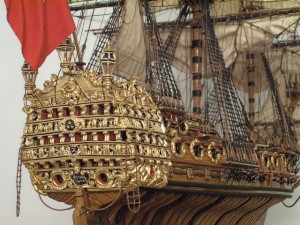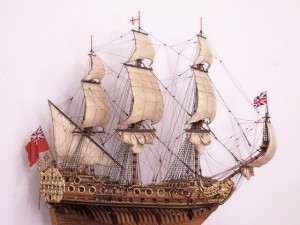Man Of War Ship
Highly versatile and powerful ships capable of trade, diplomacy and combat, the man of war was the most prominent of armed ships from the 16th to 19th Century.
Spanning a whole variety of ship designs from the 1500s to 1850, but typified by the galleon and ship of the line class of vessels, man of war ships were exemplars of ship-building expertise, delivering high manoeuvrability, storage capacity and firepower. They worked by taking the roundship and cog ship designs that had been the staple for European trade, transport and warfare since medieval times – both were powered by oars instead of sails – and added multiple masts, decks and cannons as well as more advanced rudder systems. These additions meant that long-scale voyages were now possible, opening up the largely uncharted world to nations and merchants looking to exploit the Earth’s natural resources – events that lead to the great Age of Discovery.
One of the most notable man of war ship designs was that devised by Sir John Hawkins, treasurer and controller of the British Royal Navy for Elizabeth I, and a key player in defeating the Spanish Armada in 1588. Hawkins’ man of war – a name chosen by Henry VIII – was adapted from the Spanish galleon and Portuguese carrack and had three masts, was 60 metres long and sported a maximum of 124 cannons, four at the front, eight at the back and 56 on each side. Powered by sail and with a high (for the time) top speed of nine knots, Hawkins’ man of war proved to be incredibly successful through the 17th and 18th Centuries. It was chosen and adapted by Sir Francis Drake on numerous expeditions.
 The last man of war ships to be designed were the grade-one listed ships of the line in the late-i8thand 19th Centuries. These were colossal warships designed to be used in line of battle warfare, a naval tactic where two columns of opposing ships would try to out-manoeuvre each other to bring their largest cannons into range of the enemy. They were built primarily for combat and – as was demonstrated on Lord Nelson’s well-known flagship HMS Victory, which sported a massive array of 32, 24 and 12-pounder cannons -were incredibly well-armed. For these first-rate ships of the line, trade was merelyan afterthought, coming behind transport, diplomacy and combat in both functionally and priority.
The last man of war ships to be designed were the grade-one listed ships of the line in the late-i8thand 19th Centuries. These were colossal warships designed to be used in line of battle warfare, a naval tactic where two columns of opposing ships would try to out-manoeuvre each other to bring their largest cannons into range of the enemy. They were built primarily for combat and – as was demonstrated on Lord Nelson’s well-known flagship HMS Victory, which sported a massive array of 32, 24 and 12-pounder cannons -were incredibly well-armed. For these first-rate ships of the line, trade was merelyan afterthought, coming behind transport, diplomacy and combat in both functionally and priority.
Man of war evolution
Follow the chronological development of the man of war!
15th-16th Century (caravel) A small, highly manoeuvrable sailing ship developed in the 15th Century by the Portuguese, the caravel was the predominant exploration and trading vessel at the time operating in Europe and Africa. It was also used in naval warfare.
15th-16th Century (carrack) A three or four-masted ship used in Europe, the carrack is considered the forerunner of the great ships of the age of sail. Slightly larger than the caravel it could undertake longer trading journeys. It was armed with few cannons.
16th-18th Century (galleon) Used for both trade and warfare, the galleon evolved from the carrack, and included a lowered forecastle and elongated hull for improved stability and manoeuvrability. It had multiple cannons on multiple decks and became a major fighting ship.
17th-19th Century (frigate) Smaller than galleons, frigates were similar to ships of the line but were faster and lightly armed. They were often used for patrolling and escort missions as well as protecting trade ships and trade routes with their cannons and crew.
17th-19th Century (ship of the line) The largest ships built in the great age of sail were ships of the line, massive warships designed to engage with each other in line warfare. These were primarily combat vehicles and sported monumental firepower.
Facts about Man of War
 Caravel – The man of war developed from the Portuguese trading ship the caravel, designed by Prince Henry the Navigator for exploration and to expand trade routes.
Caravel – The man of war developed from the Portuguese trading ship the caravel, designed by Prince Henry the Navigator for exploration and to expand trade routes.
Galleon – During the 15th Century the caravel was adapted by the Spanish into the larger galleon type. These ships were more heavily armed than their predecessors.
Henry VIII – The first English man of war was named by Henry VIII in the 16th Century, who used the ships to travel while performing diplomatic missions abroad.
(Image used above is amazing ship model made by – Den Holmes)
1588 – Heading up Henry VIII’s navy was John Hawkins, the ship builder and slave trader who went on to be knighted after the Spanish navy was destroyed in 1588.
Drake – The versatility of the man of war didn’t go unnoticed; Sir Francis Drake adapted its design to develop a smaller more agile ship referred to as the frigate.
